Functional Communication Training
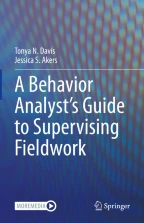
Functional communication training (FCT) is a differential reinforcement of an alternative behavior in which the alternative behavior is a socially appropriate, generally recognized communication response. In most cases, clinicians implementing FCT place challenging behavior on extinction, but this is not a requirement of FCT. In order to implement FCT, a clinician must first conduct a functional analysis to identify the function of the target challenging behavior. Next, the clinician selects a communication response that requires low response effort and is within the client’s repertoire. A mand assessment is helpful for this process. During the group supervision meeting, you will share relevant concepts and terminology with your supervisees, followed by you supervisees delivering short presentations on recent FCT research. Before the individual supervision meeting without a client, your supervisee will conduct a mand assessment with their client. You will use these results to develop an individualized FCT protocol. During the final meeting, you will observe your supervisee implementing FCT and then deliver performance feedback.
This is a preview of subscription content, log in via an institution to check access.
Access this chapter
Subscribe and save
Springer+ Basic
€32.70 /Month
- Get 10 units per month
- Download Article/Chapter or eBook
- 1 Unit = 1 Article or 1 Chapter
- Cancel anytime
Buy Now
Price includes VAT (France)
eBook EUR 106.99 Price includes VAT (France)
Softcover Book EUR 137.14 Price includes VAT (France)
Hardcover Book EUR 210.99 Price includes VAT (France)
Tax calculation will be finalised at checkout
Purchases are for personal use only
References
- Carr, E. G., & Durand, V. M. (1985). Reducing behavior problems through functional communication training. Journal of Applied Behavior Analysis, 18(2), 111–126. ArticlePubMedPubMed CentralGoogle Scholar
- Davis, T. N., Weston, R., Hodges, A., Uptegrove, L., Williams, K., & Schieltz, K. M. (2018). Functional communication training and demand fading using concurrent schedules of reinforcement. Journal of Behavioral Education, 27(3), 343–357. ArticleGoogle Scholar
- Derby, K., Fisher, W. W., Piazza, C. C., Wilke, A. E., & Johnson, W. (1998). The effects of noncontingent and contingent attention for self-injury, manding, and collateral responses. Behavior Modification, 22, 474–484. ArticlePubMedGoogle Scholar
- Durand, V. (1999). Functional communication training using assistive devices: Recruiting natural communities of reinforcement. Journal of Applied Behavior Analysis, 32, 247–267. ArticlePubMedPubMed CentralGoogle Scholar
- Falcomata, T., & Wacker, D. P. (2013). On the use of strategies for programming generalization during functional communication training: A review of the literature. Journal of Developmental and Physical Disabilities, 25(1), 5–15. ArticleGoogle Scholar
- Fisher, W. W., Piazza, C. C., Cataldo, M. F., Harrell, R., Jefferson, G., & Conner, R. (1993). Functional communication training with and without extinction and punishment. Journal of Applied Behavior Analysis, 26, 23–36. ArticlePubMedPubMed CentralGoogle Scholar
- Gerow, S., Davis, T., Radhakrishnan, S., Gregori, E., & Rivera, G. (2018). Functional communication training: The strength of evidence across disabilities. Exceptional Children, 85(1), 86–103. ArticleGoogle Scholar
- Hagopian, L. P., Fisher, W. W., Sullivan, M. T., Acquisto, J., & LeBlanc, L. A. (1998). Effectiveness of functional communication training with and without extinction and punishment: A summary of 21 inpatient cases. Journal of Applied Behavior Analysis, 31, 211–235. ArticlePubMedPubMed CentralGoogle Scholar
- Hagopian, L. P., Boelter, E. W., & Jarmolowicz, D. P. (2011). Reinforcement schedule thinning following functional communication training: Review and recommendations. Behavior Analysis in Practice, 4(1), 4–16. ArticlePubMedPubMed CentralGoogle Scholar
- Hernandez, E., Hanley, G. P., Ingvarsson, E. T., & Tiger, J. H. (2007). A preliminary evaluation of the emergence of novel mand forms. Journal of Applied Behavior Analysis, 40(1), 137–156. ArticlePubMedPubMed CentralGoogle Scholar
- Horner, R. H., & Day, H. M. (1991). The effects of response efficiency on functionally equivalent competing behaviors. Journal of Applied Behavior Analysis, 24(4), 719–732. ArticlePubMedPubMed CentralGoogle Scholar
- Landa, R. K., Hanley, G. P., Gover, H. C., Rajaraman, A., & Ruppel, K. W. (2022). Understanding the effects of prompting immediately after problem behavior occurs during functional communication training. Journal of Applied Behavior Analysis, 55(1), 121–137. ArticlePubMedGoogle Scholar
- Matter, A. L., & Zarcone, J. R. (2017). A comparison of existing and novel communication responses used during functional communication training. Behavioral Interventions, 32(3), 217–224. ArticleGoogle Scholar
- Peck, S. M., Wacker, D. P., Berg, W. K., Cooper, L. J., Brown, K. D., Richman, D., et al. (1996). Choice-making treatment of young children’s severe behavior problems. Journal of Applied Behavior Analysis, 29, 263–290. ArticlePubMedPubMed CentralGoogle Scholar
- Richman, D. M., Wacker, D. P., & Winborn, L. (2001). Response efficiency during functional communication training: Effects of effort on response allocation. Journal of Applied Behavior Analysis, 34(1), 73–76. ArticlePubMedPubMed CentralGoogle Scholar
- Ringdahl, J. E., Falcomata, T. S., Christensen, T. J., Bass-Ringdahl, S. M., Lentz, A., Dutt, A., & Schuh-Claus, J. (2009). Evaluation of a pretreatment assessment to select mand topographies for functional communication training. Research in Developmental Disabilities, 30, 330–341. ArticlePubMedGoogle Scholar
- Ringdahl, J. E., Berg, W. K., Wacker, D. P., Ryan, S., Ryan, A., Crook, K., & Molony, M. (2016). Further demonstrations of individual preference among mand modalities during functional communication training. Journal of developmental and physical disabilities, 28(6), 905–917. Google Scholar
- Tiger, J. H., Hanley, G. P., & Bruzek, J. (2008). Functional communication training: A review and practical guide. Behavior Analysis in Practice, 1(1), 16–23. ArticlePubMedPubMed CentralGoogle Scholar
- Winborn, L., Wacker, D. P., Richman, D. M., Asmus, J., & Geier, D. (2002). Assessment of mand selection for functional communication training packages. Journal of Applied Behavior Analysis, 35, 295–298. ArticlePubMedPubMed CentralGoogle Scholar
Author information
Authors and Affiliations
- Baylor University, Waco, TX, USA Tonya N. Davis & Jessica S. Akers
- Tonya N. Davis
You can also search for this author in PubMed Google Scholar
You can also search for this author in PubMed Google Scholar
Electronic Supplementary Material
(PPTX 509 KB)
Appendices
Appendix A: Selecting a Recognized Mand
Scenario One: Rashid’s FBA concluded that his challenging behavior is maintained by access to attention from his mom and dad. Rashid communicates with a speech-generating device with a static display of four icons.
- Recognizable FCR 1: ________________________________________________
- Recognizable FCR 2: ________________________________________________
- Unrecognizable FCR 1: _______________________________________________
- Unrecognizable FCR 2: ______________________________________________
Scenario Two: Marcella’s FBA concluded that her challenging behavior is maintained by access to her My Little Ponies. Marcella communicates with two- and three-word vocalizations.
- Recognizable FCR 1: ________________________________________________
- Recognizable FCR 2: ________________________________________________
- Unrecognizable FCR 1: ______________________________________________
- Unrecognizable FCR 2: ______________________________________________
Scenario Three: Stella’s FBA concluded that her challenging behavior is maintained by escaping chores in her group home, including washing dishes and taking out the trash. Stella communicates with one-word vocal approximations and two-word phrases on a speech generating application on her tablet computer.
- Recognizable FCR 1: ________________________________________________
- Recognizable FCR 2: ________________________________________________
- Unrecognizable FCR 1: ______________________________________________
- Unrecognizable FCR 2: ______________________________________________
Scenario Four: Dominic’s FBA concluded that his challenging behavior is maintained by access to his preferred snacks, including a yogurt cup. Dominic communicates with a picture exchange system and is currently able to communicate by placing two cards on a sentence strip.
- Recognizable FCR 1: ________________________________________________
- Recognizable FCR 2: ________________________________________________
- Unrecognizable FCR 1: _______________________________________________
- Unrecognizable FCR 2: _______________________________________________
Scenario Five: Abby’s FBA concluded that her challenging behavior is maintained by access to attention from a paraprofessional in her classroom, Ms. Robins. Abby communicates with a picture exchange system and is currently able to select a single picture from an array of 10 and hand it to her communication partner.
- Recognizable FCR 1: ________________________________________________
- Recognizable FCR 2: ________________________________________________
- Unrecognizable FCR 1: ______________________________________________
- Unrecognizable FCR 2: _______________________________________________
Appendix B: Selecting a Mand That Requires Low Response Effort
Scenario One: Rashid’s FBA concluded that his challenging behavior is maintained by access to attention from his mom and dad. Rashid communicates with a speech-generating device with a static display of four icons.
- Low Response Effort: ________________________________________________
- High Response Effort: ________________________________________________
Scenario Two: Marcella’s FBA concluded that her challenging behavior is maintained by access to her My Little Ponies. Marcella communicates with two- and three-word vocalizations.
- Low Response Effort: ________________________________________________
- High Response Effort: ________________________________________________
Scenario Three: Stella’s FBA concluded that her challenging behavior is maintained by escaping chores in her group home, including washing dishes and taking out the trash. Stella communicates with one-word vocal approximations and two-word phrases on a speech generating application on her tablet computer.
- Low Response Effort: ________________________________________________
- High Response Effort: ________________________________________________
Scenario Four: Dominic’s FBA concluded that his challenging behavior is maintained by access to his preferred snacks, including a yogurt cup. Dominic communicates with a picture exchange system and is currently able to communicate by placing two cards on a sentence strip.
- Low Response Effort: ________________________________________________
- High Response Effort: ________________________________________________
Scenario Five: Abby’s FBA concluded that her challenging behavior is maintained by access to attention from a paraprofessional in her classroom, Ms. Robins. Abby communicates with a picture exchange system and is currently able to select a single picture from an array of 10 and hand it to her communication partner.
- Low Response Effort: ________________________________________________
- High Response Effort: ________________________________________________
Appendix C: Teaching and Reinforcing the FCR
Scenario One: Rashid’s FBA concluded that his challenging behavior is maintained by access to attention from his mom and dad. Rashid communicates with a speech-generating device with a static display of four icons.

Scenario Two: Marcella’s FBA concluded that her challenging behavior is maintained by access to her My Little Ponies. Marcella communicates with two- and three-word vocalizations.

Scenario Three: Stella’s FBA concluded that her challenging behavior is maintained by escaping chores in her group home, including washing dishes and taking out the trash. Stella communicates with one-word vocal approximations and two-word phrases on a speech generating application on her tablet computer.

Scenario Four: Dominic’s FBA concluded that his challenging behavior is maintained by access to his preferred snacks, including a yogurt cup. Dominic communicates with a picture exchange system and is currently able to communicate by placing two cards on a sentence strip.

Scenario Five: Abby’s FBA concluded that her challenging behavior is maintained by access to attention from a paraprofessional in her classroom, Ms. Robins. Abby communicates with a picture exchange system and is currently able to select a single picture from an array of 10 and hand it to her communication partner.

Appendix D: Mand Topography Assessment: Instructions and Data Sheet
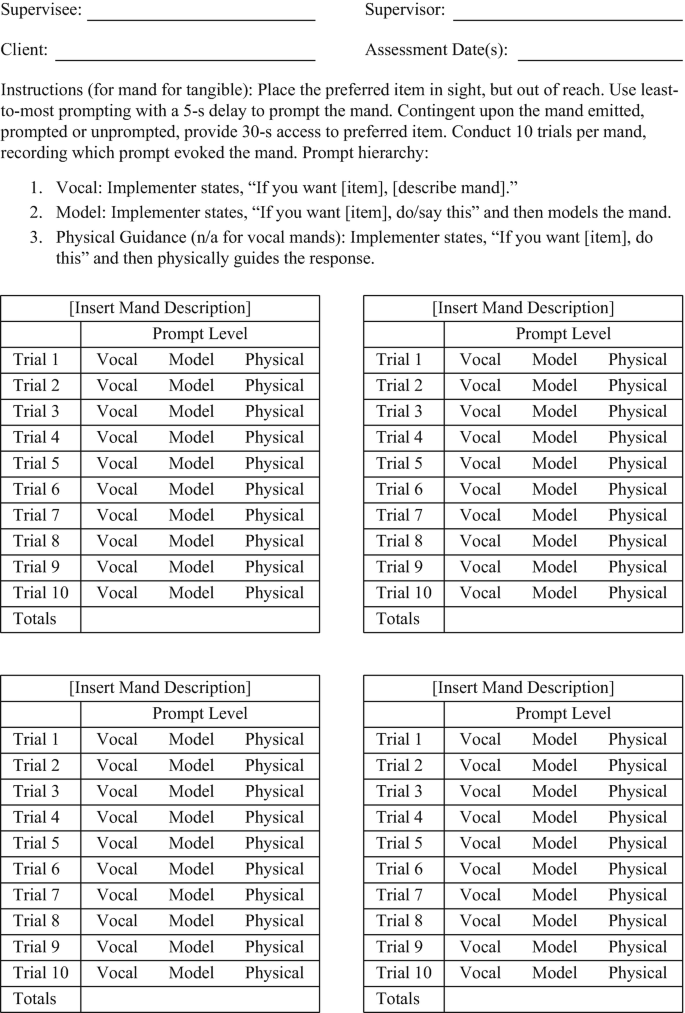
Appendix E: Mand Topography Assessment: Sample Data Sheets
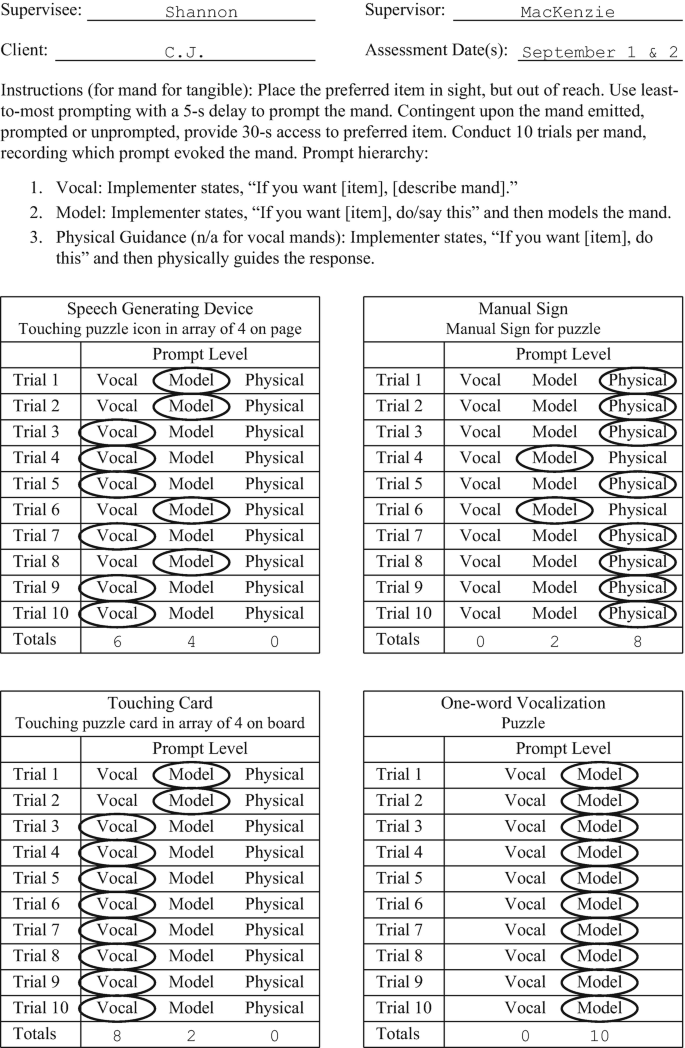
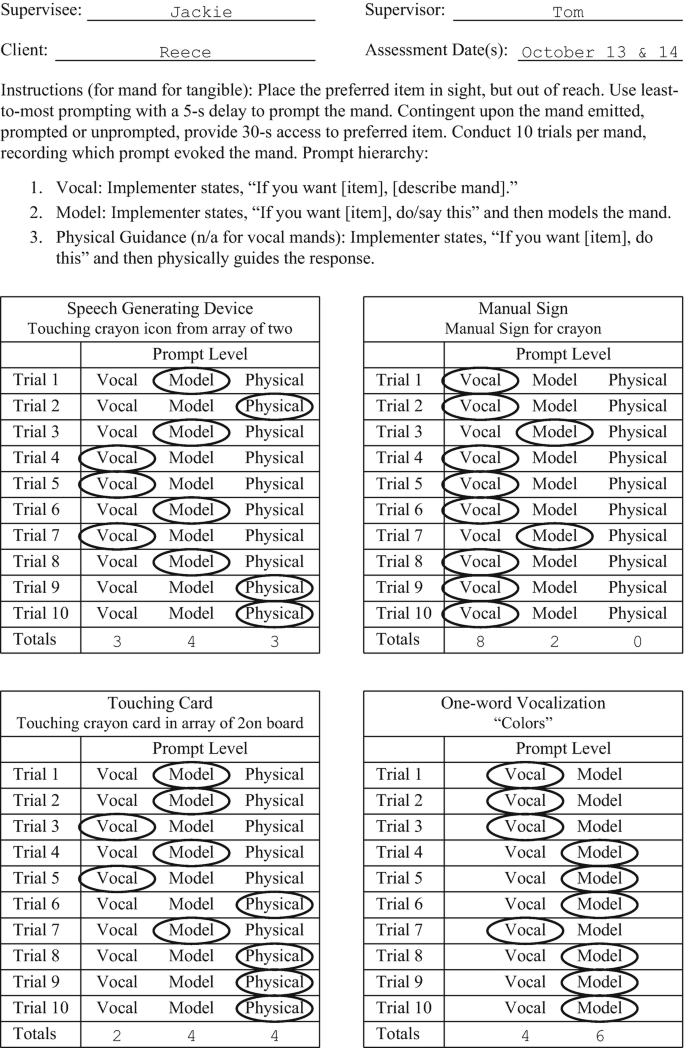

Appendix F: FCT Planning Guide
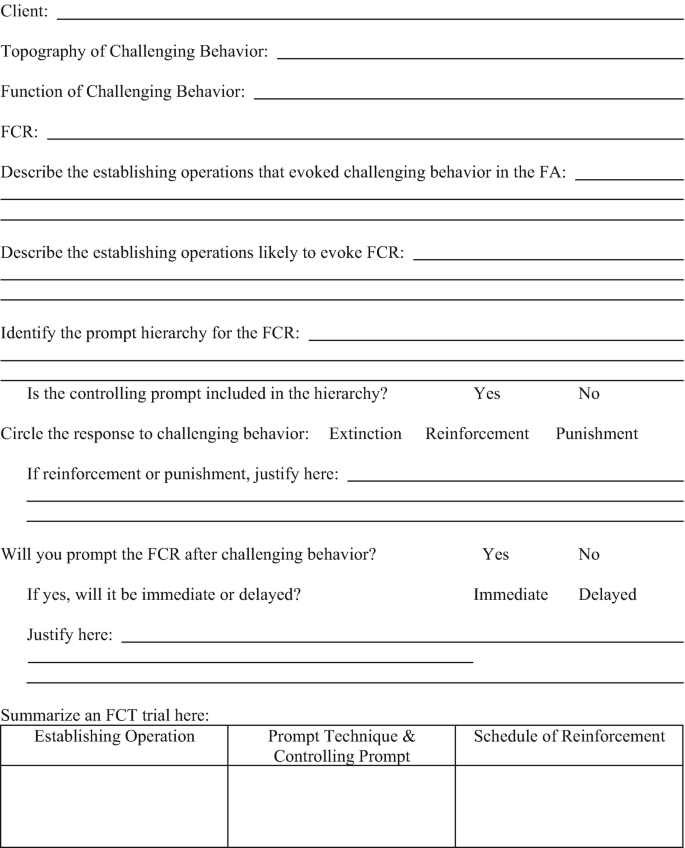
Appendix G: FCT: Procedural Fidelity Checklist Template
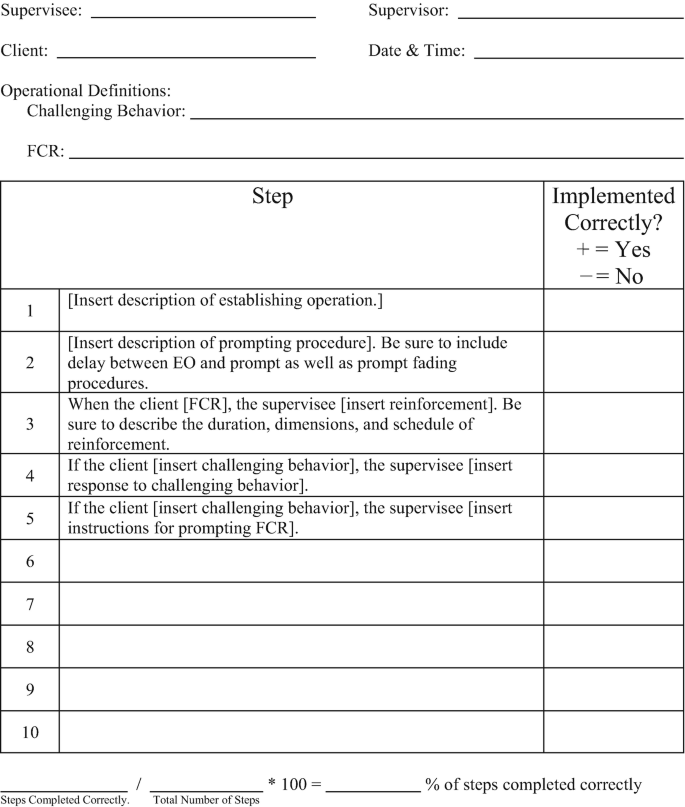
Appendix H: FCT Role-Play Data Collection
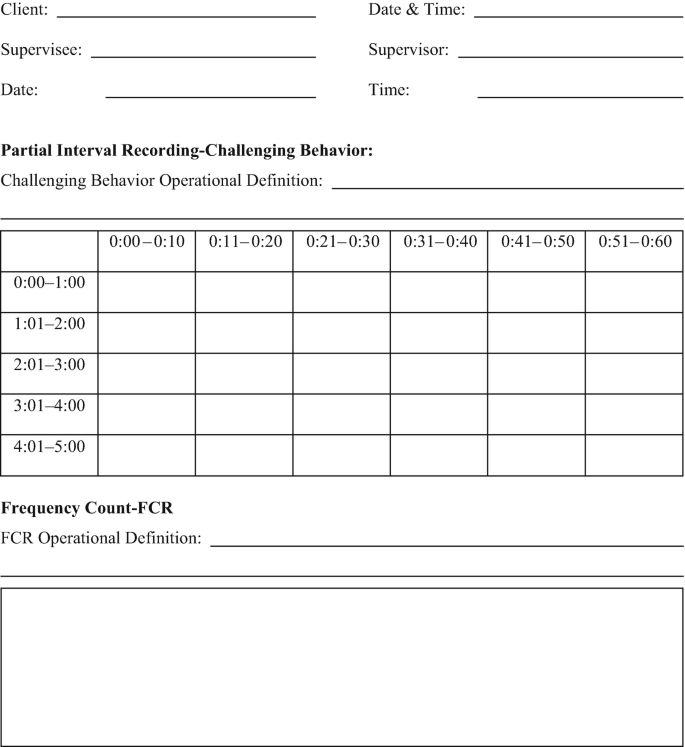
Rights and permissions
Copyright information
© 2022 The Author(s), under exclusive license to Springer Nature Switzerland AG
About this chapter
Cite this chapter
Davis, T.N., Akers, J.S. (2022). Functional Communication Training. In: A Behavior Analyst’s Guide to Supervising Fieldwork. Springer, Cham. https://doi.org/10.1007/978-3-031-09932-8_25
Download citation
- DOI : https://doi.org/10.1007/978-3-031-09932-8_25
- Published : 06 January 2023
- Publisher Name : Springer, Cham
- Print ISBN : 978-3-031-09931-1
- Online ISBN : 978-3-031-09932-8
- eBook Packages : Behavioral Science and PsychologyBehavioral Science and Psychology (R0)
Share this chapter
Anyone you share the following link with will be able to read this content:
Get shareable link
Sorry, a shareable link is not currently available for this article.
Copy to clipboard
Provided by the Springer Nature SharedIt content-sharing initiative













